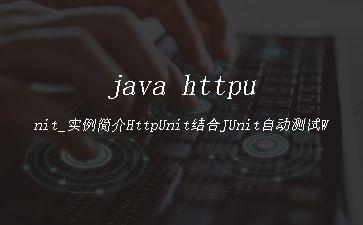本文通过实例来讲解如何通过HttpUnit来对web应用进行测试,尤其是当下Ajax越来越流行的情况下,http request和response交互频繁,里面传输的内容也以Json或者XML为主,用HttpUnit结合JUnit来做测试可以带来很多好处,甚至是在web页面还不存在的情况下,通过模拟http请求,包括模拟上传文件,就可以用来测试服务端的servlet,action(有httprequest参数)等代码.
JAVA实例代码
HTTPStub :包装了HttpUnit提供的一些类,同时在初始化的时候做login验证,WebConversation会维护session的信息.
public class HTTPStub {
private WebConversation httpConversation;
private PostMethodWebRequest httpRequest;
public HTTPStub() {
httpConversation = new WebConversation();
String urlLogin = EnvConstant.SERVER_CTXT + EnvConstant.SERVER_LOGINURL;
GetMethodWebRequest getReq = new GetMethodWebRequest(urlLogin);
try {
httpConversation.getResponse(getReq);
} catch (IOException e1) {
// TODO Auto-generated catch block
e1.printStackTrace();
} catch (SAXException e1) {
// TODO Auto-generated catch block
e1.printStackTrace();
}
}
public void initHttpRequest(String url) {
httpRequest = new PostMethodWebRequest(EnvConstant.SERVER_CTXT + url, true);
}
public void setParameter(String name, String value) {
httpRequest.setParameter(name, value);
}
public void setFile(String Filename) {
InputStream inputStream = FileUtil.readFromdefaultClspath(Filename);
httpRequest.selectFile(“dumyfile”, “dumyfile.csv”, inputStream, “text/plain”);
}
public WebResponse getHttpResponse() {
try {
return httpConversation.getResponse(httpRequest);
} catch (IOException e) {
// TODO Auto-generated catch block
e.printStackTrace();
} catch (SAXException e) {
// TODO Auto-generated catch block
e.printStackTrace();
}
return null;
}
public String getHttpResponseContents() {
try {
WebResponse resp = httpConversation.getResponse(httpRequest);
StringBuffer strbf = new StringBuffer();
BufferedReader in = new BufferedReader(new InputStreamReader(resp.getInputStream()));
String str;
while ((str = in.readLine()) != null) {
strbf.append(str);
}
in.close();
return strbf.toString();
} catch (IOException e) {
// TODO Auto-generated catch block
e.printStackTrace();
} catch (SAXException e) {
// TODO Auto-generated catch block
e.printStackTrace();
}
return null;
}
}
对inputstream处理的一个util类:
public class FileUtil {
public static InputStream readFromdefaultClspath(String fileName) {
InputStream stream = ClassLoader.getSystemResourceAsStream(fileName);
return stream;
}
public static String getContentsFromFile(String fileName) {
InputStream stream = readFromdefaultClspath(fileName);
StringBuffer strbf = new StringBuffer();
try {
BufferedReader in = new BufferedReader(new InputStreamReader(stream));
String str;
while ((str = in.readLine()) != null) {
strbf.append(str);
}
in.close();
} catch (IOException e) {
e.printStackTrace();
}
return strbf.toString();
}
}
Junit测试类:
public class ActionCopyBillTest {
private HTTPStub httpStub;
@Before
public void setUp() throws Exception {
httpStub = new HTTPStub();
}
@After
public void tearDown() throws Exception {
}
@Test
public void testPerform() {
httpStub.initHttpRequest(“FrontController?command=CopyBill”);
httpStub.setParameter(“bm_cb_dtCategory”, “Copy Bill Request”);
httpStub.setParameter(“bm_cb_SRID”, “SR0001”);
httpStub.setParameter(“bm_cb_ItemOpt”, “2- Custom Itemisation”);
httpStub.setParameter(“bm_cb_BillLanCode”, “ENG”);
httpStub.setParameter(“bm_cb_LegendPrs”, “Copy Legend”);
httpStub.setParameter(“bm_cb_BillStruct”, “Front Page Only”);
httpStub.setParameter(“bm_cb_ItemThd”, “1”);
httpStub.setParameter(“bm_cb_BillMedia”, “Paper Bill”);
httpStub.setParameter(“bm_cb_BillFormat”, “Blue Bill”);
httpStub.setFile(“testdata/req/CopyBill_1.csv”);
String respContents = httpStub.getHttpResponseContents();
String ritContents = FileUtil.getContentsFromFile(“testdata/rep/CopyBill_1.rsp”);
Assert.assertEquals(respContents, ritContents);
}
}
如果想对response进行验证,可以通过手工从html页面输入数据,提交请求,用工具(如eclipse带有的插件tcp/ip monitor)将response截取下来保存为文件,然后和junit测试的时候的response对比.
另外,返回的response也提供了一系列方法来操作其包含的内容:
1,如返回的是文本,可以通过resp.getText()获取,如果文本是json格式,可以再进一步构造成jsonobject来操作.
String respContents = resp.getText();
JSONObject json = new JSONObject(respContents);
System.out.println(json.getInt(“total”));
JSONArray arr = json.getJSONArray(“userdata”);
System.out.println(arr.get(0));
2,如果返回的是XML(标准结构的html也是合法的XML),可以得到w3c 的document对象,resp.getDOM();
3,如果返回的是html页面,WebResponse提供了一组类似于Javascript操作html dom的方法.
resp.getElementWithID(id)
resp.getTables();
…
今天的文章java httpunit_实例简介HttpUnit结合JUnit自动测试Web应用分享到此就结束了,感谢您的阅读,如果确实帮到您,您可以动动手指转发给其他人。
版权声明:本文内容由互联网用户自发贡献,该文观点仅代表作者本人。本站仅提供信息存储空间服务,不拥有所有权,不承担相关法律责任。如发现本站有涉嫌侵权/违法违规的内容, 请发送邮件至 举报,一经查实,本站将立刻删除。
如需转载请保留出处:https://bianchenghao.cn/31192.html

